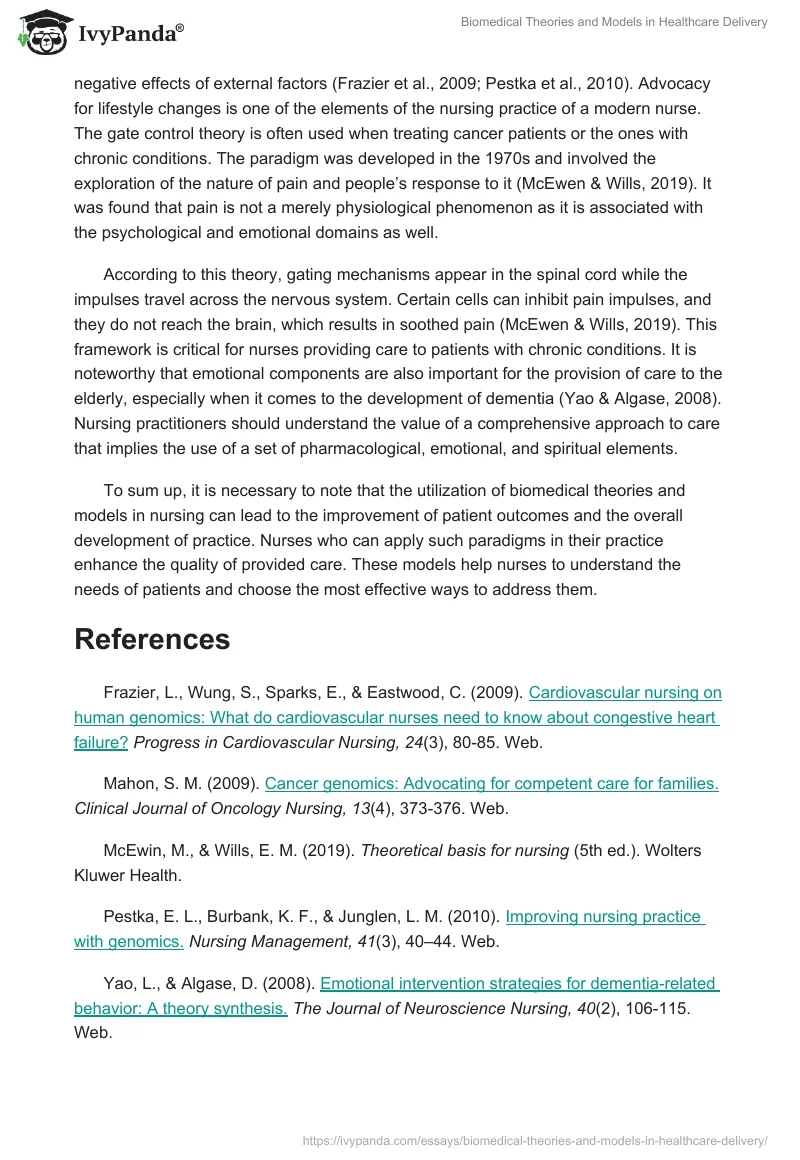Biomedical theories and models provide sound evidence-based frameworks that can be effectively utilized in care delivery. Nurses can apply certain models to ensure the provision of high-quality and patient-centered care (McEwen & Wills, 2019). These models offer a scientific view of patients’ health conditions, so nursing professionals have a clear picture related to symptoms, factors affecting diseases, ways humans respond to specific types of interventions, and so on. This paper includes a brief analysis of some biomedical theories and the ways they can be utilized in nursing practice.
Several cancer theories have been developed and widely used in health care. The genetic basis of cancer theory is one of these paradigms, and it focuses on the genesis of the disease. According to this framework, cancer development can be divided into three stages, initiation, promotion, and progression (McEwen & Wills, 2019). A combination of factors leads to the occurrence and proliferation of cancer cells.
Cells undergo multiple mutations affecting the pace of their proliferation, response to the immune system, and so on. Chemical carcinogens and radiation are common factors damaging cells’ DNA, which leads to their malfunction. Hormones (for example, estrogen) often trigger the proliferation of cells and tumor growth. A mutated cell receives signals from the body’s nervous system (regarding its development patterns, type, and number of divisions) but responds differently due to the mutation. This altered cell also starts proliferating at a considerably higher pace as compared to healthy cells, creating tumors. Due to the mutation, the altered cell cannot be repaired by the immune system. Thus, the body is usually unable to control the division and growth of such cells and repair damage, which leads to prompt the growth of tumors.
This theory is rather common and has been employed as a framework in diverse studies. For instance, Mahon (2009) stated that cancer genomics could be instrumental in improving patient outcomes as nurses could provide educational services to patients and their families. Nursing professionals should educate people on the nature of their health condition (genetic and environmental aspects), as well as ways to mitigate the negative effects of external factors (Frazier et al., 2009; Pestka et al., 2010). Advocacy for lifestyle changes is one of the elements of the nursing practice of a modern nurse. The gate control theory is often used when treating cancer patients or the ones with chronic conditions. The paradigm was developed in the 1970s and involved the exploration of the nature of pain and people’s response to it (McEwen & Wills, 2019). It was found that pain is not a merely physiological phenomenon as it is associated with the psychological and emotional domains as well.
According to this theory, gating mechanisms appear in the spinal cord while the impulses travel across the nervous system. Certain cells can inhibit pain impulses, and they do not reach the brain, which results in soothed pain (McEwen & Wills, 2019). This framework is critical for nurses providing care to patients with chronic conditions. It is noteworthy that emotional components are also important for the provision of care to the elderly, especially when it comes to the development of dementia (Yao & Algase, 2008). Nursing practitioners should understand the value of a comprehensive approach to care that implies the use of a set of pharmacological, emotional, and spiritual elements.
To sum up, it is necessary to note that the utilization of biomedical theories and models in nursing can lead to the improvement of patient outcomes and the overall development of practice. Nurses who can apply such paradigms in their practice enhance the quality of provided care. These models help nurses to understand the needs of patients and choose the most effective ways to address them.
References
Frazier, L., Wung, S., Sparks, E., & Eastwood, C. (2009). Cardiovascular nursing on human genomics: What do cardiovascular nurses need to know about congestive heart failure?Progress in Cardiovascular Nursing, 24(3), 80-85. Web.
Mahon, S. M. (2009). Cancer genomics: Advocating for competent care for families.Clinical Journal of Oncology Nursing, 13(4), 373-376. Web.
McEwin, M., & Wills, E. M. (2019). Theoretical basis for nursing (5th ed.). Wolters Kluwer Health.
Pestka, E. L., Burbank, K. F., & Junglen, L. M. (2010). Improving nursing practice with genomics.Nursing Management, 41(3), 40–44. Web.
Yao, L., & Algase, D. (2008). Emotional intervention strategies for dementia-related behavior: A theory synthesis.The Journal of Neuroscience Nursing, 40(2), 106-115. Web.


